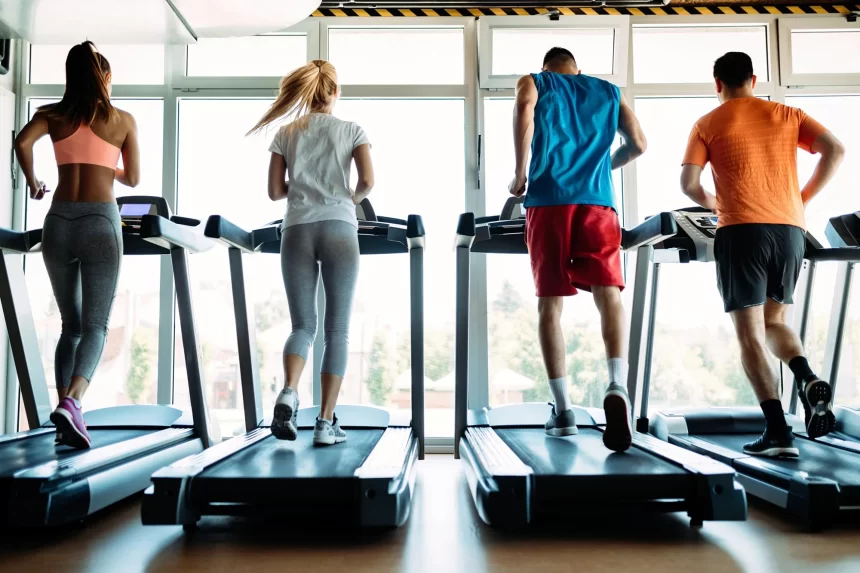After almost two decades of regular gym-going, I’ve finally cancelled my membership. The reasons for this are many and varied – I’m trying to save money, gym music is terrible these days, everyone seems to have forgotten how to share the equipment – but the main one is, I think it may actually make me fitter.
Working for Men’s Fitness magazine for almost 10 years, I got to try out every trend, workout style and fitness event I wanted, and I noticed something interesting: quite frequently, the people with the fewest resources were in the best shape. I’m not including Hollywood actors in this, but otherwise, it’s often true: powerlifters working out in unheated concrete sheds get the strongest, runners who stay off treadmills get the fastest, and people exercising in basements have a focus rarely seen in palatial upmarket gyms. Browsing through photos from when my own gym membership was (briefly) paused during Covid lockdowns, I look … if not quite like Jason Statham, then at least his off-brand office-party equivalent. I might not have had the best cardio of my life – even social distancing couldn’t convince me to run more than three miles (5km) at a time – but I was certainly lean.
Some of the correlation and causation here might be muddled, obviously – Covid also prevented me from getting to my favourite cake shop – but let’s not worry about that right now.
So what’s the plan? Well, as a 46-year-old father with a lot to do, I’m focusing on fitting workouts into my life wherever is feasible, combining cardio, strength and mobility as much as possible, and buying as little kit as I can. Here’s what I’m up to.
Running, fast and slow
Over recent years, it’s become increasingly clear that VO2 max, a measure of your body’s ability to use oxygen during intense exercise, is a key indicator of health and lifespan: to the extent that it’s probably one of the main things worth focusing on for longevity. Unfortunately, building up a good VO2 max takes a little bit longer than getting strong – but there are things you can do to speed the whole process along.
One is the so-called “Norwegian protocol”: working out at a high intensity for four minutes, then at a lower intensity for three minutes, then repeating – four times altogether. With a warmup on top, you’re done in little more than 30 minutes – and if you do that once a week, any other running workouts can be more ponderous or plodding. Recently, I’ve been a regular at my local Parkrun, which is always delightful – there are plenty of people far faster than me to keep me motivated, but nobody bats an eye if you put an audiobook on and turn in a 40-minute three miles.
The final thing I’m doing run-wise is hill “sprints” – a bit of a misnomer, as my nearest hummock is angled so steeply that I can barely get up it faster than a jog. This is actually a good thing; with a couple of hamstring pings in my past, my actual sprinting days are probably over, but the hilly variety still force you to work hard, generate power with each stride, and recruit dozens of muscle fibres with every step.
Being strong is good for you: apart from the obvious benefits (carrying furniture, shopping and weary children), it can improve bone density, balance and mobility, heart health, and might even have protective effects against dementia. Some sort of strength training should be a non-negotiable part of your workout week, but the good news is that it really doesn’t have to take long – recent research suggests that two “sets” of exercise per body part, per week can be enough to build strength, with the diminishing returns kicking in quickly afterwards.
These workouts can also be very simple: unless you want to look like a Marvel character, there’s no need for dozens of movements. All you really need to focus on is what many trainers call the fundamental human movements: push, pull, squat, “hinge”, and carry – all of which can be done with a kettlebell, set of dumbells, or a bag of books if you’re on a budget. My twice-weekly strength plan is as simple as it gets: two sets each of overhead presses (push), one-armed rows (pull) and goblet squats (hopefully obvious), and one set of kettlebell swings (this is the “hinge”, but so is any movement where the power comes from your hips, from picking a weight off the ground to doing the long jump). I get my carrying by doing the shopping – I usually do a big bagload or two once or twice a week.
Greasing the groove
This style of working out – popularised by former Soviet strength coach Pavel Tsatsouline – has been around for decades, but it’s never been more relevant than in an era where lots of people work from home. The idea is that you’re getting into the groove of the movements you do a lot, so not just working out your muscles but also your neuromuscular efficiency, or how well your brain and nervous system can activate your muscles.
Basically, you do one or two exercises at a relatively manageable intensity multiple times throughout the day, rather than in one workout session. Each set ought to feel fairly easy (you never go to “failure”, or even get sweaty), allowing you to focus on perfect form and make your body more efficient at recruiting muscle fibers. It won’t make you huge, if that’s the goal – but it will make you stronger.
I’m currently doing it with pullups. There’s a bar in my kitchen, so whenever I let our new pup out in the garden – for a wee, for a little dash around, for the sheer joy of trying to eat a plastic plant-pot – I do seven or eight pullups, or roughly half the number I could manage if I really tried. I don’t do another set for at least half an hour; I might do anywhere between three and about 10 sets a day: and in a couple of weeks, I’ll probably add a rep or two. It’s a great system for pullups, but it also works for more beginner-friendly movements – you could try it with wall pressups, squats, or lunges.










